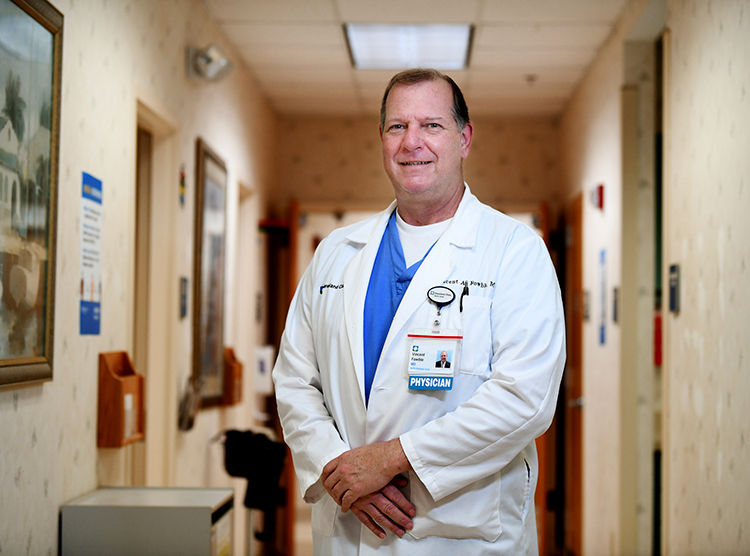
With people living longer and staying more active in their later years, more people’s knees are simply wearing out. Happily, knee replacement surgery is continually improving and has become a highly effective treatment for knee arthritis. According to the Agency for Healthcare Research and Quality, more than 790,000 knee replacements are now performed each year in the United States.
Dr. Vincent A. Fowble, board certified orthopedic surgeon and section head of the joint replacement service line at Cleveland Clinic Martin Health, said he and others at Cleveland Clinic Florida are addressing the high demand for knee replacements by “building groups within the system including a group operating out of Indian River Hospital and one that will be opening soon in Sebastian.
“Our goal is to have our team of orthopedic specialists available in every part of the Treasure Coast.”
“Most of the knee replacements we do are the results of degenerative arthritis, which causes inflammation and deterioration in the joints and damage to the articular cartilage.” explained Dr. Fowble. “The first sign of trouble is knee pain or loss of mobility. Some people have a high tolerance for pain but may notice that they have trouble putting on socks or can’t walk as far. My approach to treatment options is threefold: Live with it, treat with non-operative things like injections or explore the operative approach of knee replacement surgery. It’s their choice and all we can do as surgeons is to give them the information to choose wisely.”
Usually, the first approach is to treat the knee joint with corticosteroid injections that reduce the inflammation inside the joint. You can get these injections right in your doctor’s office, and while they won’t slow the progression of arthritis, they will temporarily relieve the pain. Typically, within three or four days after the injection the steroid should kick in and start providing relief. The pain relief from the injection can last for three to four months but should not be given more than four times a year.
“If the corticosteroids stop working, the patient may elect to try a hyaluronic acid injection, commonly known as a gel shot,” continued Dr. Fowble. “It can be given in a single large dose or in a series of smaller shots given over the course of three to four weeks. While it won’t regrow cartilage, it works by bathing the cartilage that’s left with lubrication, providing a more optimal environment for its health. Eventually, these treatments will probably lose their effectiveness and joint replacement surgery will be the best option to relieving their pain and discomfort.”
Knee replacement surgery involves removing a small portion of the bone in the knee and covering it with a combination of metal and plastic to form a new surface of the joint.
“The joint replacements themselves are pretty standardized,” explained Dr. Fowble. “The parts that articulate and move against the plastic components are made out of cobalt chromium.
“The plastic insert is a polyethylene plastic material that gives it some wear resistance. The tibial base plate is made out of either cobalt chromium or titanium. Most of advances have been in technique and the use of robotic surgery where the machine makes decisions based on your MRI or CT scans and sets up cutting guides for the surgeons.
“The biggest advancement is that patients are a lot smarter and participate in the decision-making. They get prepared in the optimization process and a rapid recovery protocol to get them back to their lives.”
When asked how long a knee replacement lasts, Dr. Fowble replied that there’s a 95 percent chance it lasts 15 to 20 years. “These are foreign parts installed in your body and a lot of it will depend on what the patient does after the replacement,” he said.
“Just as the tires on your car will wear the tread in direct proportion to the amount of driving you do, the same is true with a knee replacement. A young person who is very active and continues to run marathons is going to wear out those plastic bearings sooner that someone who is doing only low-impact exercise. They may need more than one knee replacement in their lifetime. When you’re talking about the 75-and-over crowd, one knee replacement might last a lifetime as long as they don’t overexert themselves.”
So, when Is the best time to get a knee replacement? “It’s a personal choice,” he continued. “Do you hold off and have a decreased quality of life for the next five or 10 years, or do you get it done earlier, take care of yourself and hope it lasts for the rest of your life? I always bring up the consequences of choices to my patient and allow them to decide for themselves.
“If someone chooses to have it at a younger age, it’s best to be monitored by your doctor every three to five years to see if there is any damage to the bearing. A specialist can see that part wearing down before they are against the bone and it can be corrected with a lesser surgery.
Since you aren’t doing the bony work, you clean things up, pop the plastic out and put a brand-new, thicker tread on the tires, so to speak.”
The best thing you can do after knee surgery is to shift from high-impact sports like tennis to low-impact activities like swimming and biking. “You want to keep the joints moving and keep active yet don’t be so active that you are breaking them down faster.”
Dr. Vincent A. Fowble is a fellowship trained in adult reconstruction and joint replacement and specializes in total replacement of the hip and knee, with more than 20 years of experience in the field. You can schedule an appointment at 844-630-4968.



